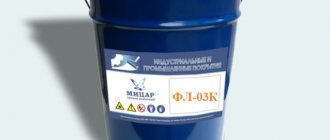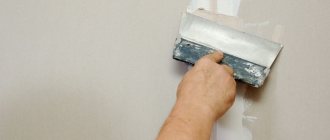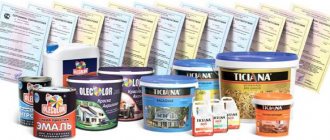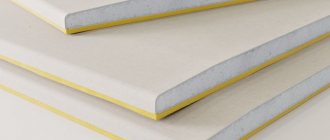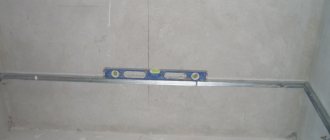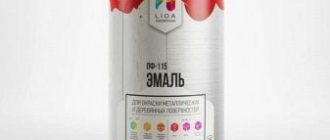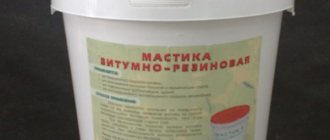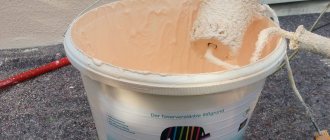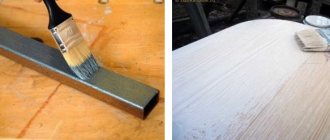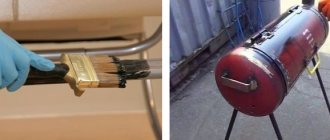GOST 2889-80
INTERSTATE STANDARD
BITUMEN ROOFING MASTIC HOT
TECHNICAL CONDITIONS
IPC PUBLISHING HOUSE OF STANDARDS Moscow
INTERSTATE STANDARD
| BITUMEN ROOFING MASTIC HOT Specifications Roof bitumen hot mastic. Specifications | GOST 2889-80 |
Date of introduction 01.01. 82
This standard applies to bitumen roofing hot mastic, which is a homogeneous mass consisting of bitumen binder and filler and used in a hot state.
Mastic can be made with the addition of antiseptics and herbicides.
The mastic is intended for installation of roll roofs, as well as mastic roofs reinforced with glass materials.
The scope of application of the mastic is given in Appendix 1.
BRANDS
1.1. Mastic, depending on heat resistance, is divided into brands indicated in the table. 1.
Table 1
| Brand | MBK-G-55 | MBK-G-65 | MBK-G-75 | MBK-G-85 | MBK-G-l00 |
| Heat resistance, °C | 55 | 65 | 75 | 85 | 100 |
1.2. The symbol for mastic brands consists of its name - hot bitumen roofing mastic and a number indicating the heat resistance of a certain brand of mastic.
In the designation of brands of mastic with additives of antiseptics or herbicides, after the designation of heat resistance, add the letter A or G, respectively.
An example of a symbol for bitumen roofing mastic with a heat resistance of 55 °C:
MBK-G-55
The same, with the addition of an antiseptic:
MBK-G-55A
The same, with the addition of herbicides:
MBK-G-55G
Types of bitumen roofing mastic
The main component of the material for roofing installation is natural bitumen, to which mineral or organic polymer fillers are added to improve properties under certain technical requirements. Commonly used are chalk, asbestos dust, mineral wool fibers, talc, dolomite, brick, quartz, and coal dust.
Fillers are added to increase the hardness and heat resistance of the coating. They maintain the elasticity of the frozen material at low temperatures. Due to additives, the amount of bitumen component used in the mixture is reduced, which reduces the cost of the mixture. Bitumen is diluted with organic solvents - acetone, diesel oil, kerosene, and with water they form fine emulsions. Mastic is produced in solid form in the form of briquettes, suspensions and solutions:
- Hot bitumen mastic, sold in solid form. To melt it to a liquid state, it is heated before starting work. To obtain a liquid mass, solid briquettes must be heated to 1600C.
- Cold application mastic. The composition, in addition to the binder, includes a solvent or thinner. It hardens after the solvent evaporates or polymerizes upon contact with the atmosphere.
By purpose:
- Adhesives used for gluing various rolled materials;
- Insulating, for use as an independent insulating material;
- Anti-corrosion;
- For arranging vapor barrier.
TECHNICAL REQUIREMENTS
2.1. The mastic must be manufactured in accordance with the requirements of this standard according to technological regulations approved in the prescribed manner.
Recommendations for the composition and preparation of mastics are given in Appendix 2.
2.2. Depending on the brand, the mastic must meet the requirements of Table. 2.
table 2
| The name of indicators | Standard for mastic brands | ||||
| MBK-G-55 | MBK-G-65 | MBK-G-75 | MBK-G-85 | MBK-G-100 | |
| 1. Heat resistance for 5 hours, °C, not less | 55 | 65 | 75 | 85 | 100 |
| 2. Softening temperature using the “ring and ball” method, °C | 55 — 60 | 68 — 72 | 78 — 82 | 88 — 92 | 105 — 110 |
| 3 Flexibility at temperature (18 ± 2) °C on a rod with diameter, mm | 10 | 15 | 20 | 30 | 40 |
| 4. Filler content,% by weight: | |||||
| - fibrous | 12 — 15 | 12 — 15 | 12 — 15 | 12 — 15 | 12 — 15 |
| - dusty | 25 — 30 | 25 — 30 | 25 — 30 | 25 — 30 | 25 — 39 |
| 5 Water content | Footprints | ||||
2.3. In appearance, the mastic must be homogeneous without foreign inclusions and particles of filler, antiseptic or herbicide, not coated with bitumen.
On a mastic cut with an area of 50 cm2 there should not be more than two unimpregnated particles of filler, antiseptic or herbicide larger than 0.4 mm in size.
2.4. The mastic must firmly glue the rolled materials. When testing glassine samples glued with mastic, the samples should break and split along the glassine.
2.5. The mastic must be easy to apply: at a temperature of 160 ° C - 180 ° C, mastic weighing 10 g should freely spread over the surface of glassine measuring (50 x 100) mm in an even layer 2 mm thick.
2.6. When transporting mastic in a hot state, the filler may settle. In this case, the amount of filler (at different levels of the vehicle) may differ from that indicated in the table. 2, respectively, for fibrous filler by no more than 3%, and for dust filler - 10%.
2.7. Requirements for materials for preparing mastics
2.7.1. Bituminous binder
2.7.1.1. As a binder for the preparation of mastic, petroleum roofing bitumen should be used that meets the requirements of GOST 9548, and their alloys, as well as petroleum road bitumen in accordance with GOST 22245 and their alloys with roofing bitumen grade BNK 90/30 (BNK 90/40).
2.7.1.2. To reduce the sedimentation of fillers, surfactants (surfactants) should be introduced into the bitumen binder.
Anionic or cationic substances should be used as surfactants.
The list of products used as surfactants is given in Appendix 3.
2.7.1.3. The following should be added to the bitumen binder used for the manufacture of mastics in winter conditions: coal oil for impregnating wood in accordance with GOST 2770, shale oil for impregnating wood in accordance with GOST 10835 or kukersol varnish according to technical specifications approved in the prescribed manner.
2.7.1.4. The softening and brittleness temperature of bitumen binder for the manufacture of mastics of different brands must meet the requirements of Table. 3.
2.7.2. Filler
2.7.2.1. To prepare mastic, fibrous or dusty fillers must be used.
Chrysotile asbestos, grade 7 according to GOST 12871, should be used as a fibrous filler.
Table 3
| Brand of mastic | Softening temperature of bitumen binder using the “ring and ball” method, °C | Brittle temperature of bitumen binder, °C, not higher |
| MBK-G-55 | 45 -50 | -18 |
| MBK-G-65 | 51 — 60 | -15 |
| MBK-G-75 | 61 — 70 | -13 |
| MBK-G-85 | 71 — 80 | -12 |
| MBK-G-100 | 85 — 95 | -10 |
Note. When introducing plasticizing additives into bitumen binder, its softening temperature can be 3 °C -5 °C lower.
As a dust filler, finely ground talc or soapstone in accordance with GOST 21235, shale rocks, limestone, dolomite, tripolite or chalk should be used according to technical specifications approved in the prescribed manner.
2.7.2.2. To reduce the sedimentation of the filler during its grinding, a surfactant based on synthetic fatty acids specified in Appendix 3 can be introduced. In this case, the surfactant is not introduced into the bitumen binder.
Note. In the case when shale rocks are used as a filler, surfactants are not introduced.
2.7.2.3. The filler for making mastic must meet the requirements of Table. 4.
Table 4
| Indicator name | Norm |
| 1. Density (specific gravity), kg/m3 (g/cm3), no more | 2,7 |
| 2. Filler moisture content, % by weight, not more than: | |
| -fibrous | 5 |
| - dusty | 3 |
| 3. Grain composition of the filler: | |
| -fibrous | Passes completely through a sieve with mesh no. 04 |
| - dusty | Passes completely through a sieve with mesh No. 02, and the remainder on the sieve with mesh No. 009 is no more than 10% |
2.7.3. Antiseptics and herbicides
2.7.3.1. Sodium silicofluoride according to TU 113-08-587 or sodium fluoride according to TU 113-08-586 should be used as antiseptic additives.
Antiseptics are not added to mastics with plasticizing additives.
2.7.3.2. Simazine in accordance with GOST 15123 or amine (sodium) salt of dichlorophenoxyacetic acid (2, 4D) should be used as herbicides according to technical specifications approved in the prescribed manner.
The amount of antiseptics and herbicides in the mastic must comply with the requirements of SNiP II-26.
Hot mastic TechnoNIKOL - material for professional use
Cold roofing bitumen mastic is a ready-to-use material, while hot bitumen mastic is melted before application, which requires special equipment. Heating temperature – up to 180 °C. The duration of heating is indicated by the manufacturer, since this not only liquefies the material, but also dehydrates it. In this case, they do not talk about melting the bitumen, but about “cooking” it.
The material is applied in a liquid state, which allows it to fill cracks and voids in the surface, causing the coating to become airtight.
Preparation of material for coating
In liquid form, cold bitumen mastic hardens as the solvent evaporates, and hot bitumen mastic hardens as it cools, so the latter hardens faster after application. At the same time, when the mastic hardens, it does not shrink, since it does not lose volume in the form of evaporating solvents.
The resulting coating has the following properties:
- resistance to external aggressive factors;
- light weight and thickness;
- elasticity;
- strength;
- resistance to corrosion, rotting;
- does not undergo oxidation and is not destroyed under the influence of ultraviolet radiation.
This coating does not have joining seams; it covers surfaces with a protective film, especially pipe outlets and interpanel seams that are difficult to seal.
Hot roofing bitumen mastic, according to GOST No. 2889-80, contains a minimum of additional components. The cost is much lower than cold-applied material and therefore it is used for large volumes of work.
SAFETY REQUIREMENTS
3.1. Mastic is a flammable material with a flash point of 240 °C - 300 °C. When manufacturing and using mastics, the requirements of the chapter of building codes and regulations must be observed.
3.2. When producing, draining, filling and sampling mastics, workwear and personal protective equipment should be used in accordance with the “Standard industry standards for the free issuance of workwear, safety footwear and safety equipment”, with the addition to them approved by the resolution of the USSR State Committee for Labor and Social Affairs and the Presidium of the All-Union Central Council of Trade Unions July 6, 1978 No. 226/P9-4.
3.3. If small quantities of mastic catch fire, the fire should be extinguished with sand, felt felt, special powders, and a foam fire extinguisher; developed fires - with a foam stream or water from fire monitors.
Recommendations for the use of roofing bitumen mastic
- Substances based on kukersol varnishes are best suited for concrete structures.
- For waterproofing, it is recommended to choose rubber-based compounds. This is explained by the fact that the solution, which includes rubber, has good elastic properties and fluidity.
- For roof installation, choose a polymer/rubber based solution.
- For spot work, oil compounds are used, as they form a coating that is resistant to high temperatures.
A common type of waterproofing mastic is bitumen mastic. Waterproofing based on it has been used for a long time, is inexpensive and provides a range of high-quality works at reasonable prices.
Traditional bitumen mastic is based on resin. Fillers and modifiers are added to it, increasing its properties and characteristics. Bitumen mastic is a universal product, valued by craftsmen, and waterproofing using it is widely used.
ACCEPTANCE RULES
1.1. The mastic must be accepted by the technical control of the manufacturer.
Acceptance and delivery of mastic is carried out in batches.
The batch size is set in the amount of replacement production of mastic prepared according to the same recipe, technology and from the same components.
4.2. To check the compliance of the mastic with the requirements of this standard, 3%, but not less than three packaging units, are selected from each batch, and the weight of each sample taken at three different levels must be at least 0.5 kg. When transported by special vehicles, a sample of 1.5 kg is taken before loading into the vehicle.
4.3. All selected samples are fused at a temperature of 120 ° C - 130 ° C, thoroughly mixed and divided into two equal parts. One of these parts is tested, the other is marked and stored in a clean, tightly closed container in a dry and cool room for control testing.
All tests are carried out on three samples.
4.4. Acceptance of mastic is carried out by carrying out acceptance control for the following indicators: appearance, heat resistance, softening point and flexibility.
4.5. The manufacturer is obliged to conduct periodic tests of the mastic according to the following indicators:
- content of filler and water in the mastic - once a month;
- determination of adhesive properties and workability - when changing the recipe, but at least once a month.
4.6. If unsatisfactory test results are obtained for at least one of the indicators, repeated tests are carried out for this indicator with a double amount of mastic selected from the same batch.
The results of repeated tests are final.
4.7. The consumer has the right to carry out a control check of the mastic in accordance with the requirements of this standard.
Types of bitumen mastic
Mastics are divided into classes that differ in composition. In this case, not all the constituent ingredients are taken into account, but only the one that interacts with the main component - bitumen.
So, there is mastic, bitumen +:
- polymer base;
- rubber base;
- cookersol mixture;
- rubber mixture;
- oils
All these materials are suitable for different jobs, so they are not divided by functionality.
Bitumen-polymer roofing mastic includes modifiers that give the material elasticity, frost and heat resistance. Rubber mastic includes rubber crumbs, thanks to which the properties of bitumen are improved - it becomes flexible, elastic, tolerates low/high temperatures and high humidity.
After applying any of the listed compositions, a monolithic surface with good vapor permeability is obtained. At the same time, the coating remains elastic in all weather conditions.
Note that any of the mastics described above is resistant to alkalis, acids and saline solutions.
TEST METHODS
5.1. Checking the appearance (uniformity of the mastic, the presence of foreign inclusions and particles of filler, antiseptic or herbicide not covered with bitumen) is carried out visually.
5.2. Determination of heat resistance
5.2.1. Equipment and accessories
Laboratory drying cabinet with perforated shelves, ventilated, allowing automatic adjustment of the set temperature.
A flat metal plate with dimensions of (50´100´2) mm.
5.2.2. Preparing for the test
To determine heat resistance, a uniform layer of 8-10 g of mastic, preheated to a temperature of 140 ° C - 160 ° C, is applied to a glassine sample measuring 50 x 100 mm. A piece of glassine of the same size is placed on top and pressed with a load of 2 N (2 kgf) for 2 hours. The load is applied through a flat metal plate measuring (50´100´2) mm.
The drying cabinet is heated, depending on the brand of mastic, to the temperature indicated in the table. 2.
5.2.3. Carrying out the test
After 2 hours of exposure, samples with mastic grades MBK-G-55 or MBK-G-65 are placed in a heated drying cabinet on an inclined stand (20%). and with mastic of the MBK-G-75, MBK-G-85, MBK-G-100 brands - on an inclined stand (100% at an angle of 45°).
The samples are kept in the cabinet for 5 hours at a given temperature, after which the samples are removed and inspected.
The mastic is considered to have passed the test if it does not flow or begin to slide.
5.3. Definition of flexibility
The method is based on bending a glassine sample with mastic applied to it along the semicircle of a rod of a certain diameter at a given temperature.
5.3.1. Equipment and accessories
Thermometer according to GOST 28498.
Rods with a diameter of 10, 15, 20, 30, 40 mm.
Vessel for water.
5.3.2. Preparing for the test
8 - 10 g of mastic, preheated to 140 °C - 160 °C, is applied in a uniform layer to a glassine sample measuring 50 x 100 mm.
After this, the sample is kept for 2 hours at a temperature of 18 ± 2 °C in air. Then water is poured into the vessel, the temperature of which should be 18 ± 2 °C.
The samples and the rod are placed in a vessel with water and kept in it for 15 minutes.
5.3.3. Carrying out the test
After soaking in water, the sample is slowly bent along the semicircle of the rod for 5 seconds with the front surface (mastic) upward. The time from the moment the sample is removed from the water and bent along the semicircle of the rod should not exceed 15 s.
The mastic is considered to have passed the test if no cracks form on the surface of the sample.
5.4. Determination of the adhesive properties of mastic
The essence of the method is to determine the load required to break two glued samples of a certain length and width.
5.4.1. Equipment and accessories
Explosive testing machine of the RT-250M-2 brand or similar machines having a working part of the scale from 0 to 100 kgf with a division value of no more than 0.2 kgf, with a permissible reading error within the working scale of ±l%.
Laboratory drying cabinet with perforated shelves, ventilated, allowing automatic temperature control.
Metal plate.
5.4.2. Preparing samples for testing
Two samples of glassine measuring 50 x 140 mm, cut from a roll in the longitudinal direction, are glued together with mastic over an area of 50 x 60 mm. Mastic heated to 140 °C - 160 °C in an amount of 4 - 6 g is applied to the surface of both samples so that one end of each sample remains uncoated with mastic. The glued samples are pressed with a load weighing 10 N (1 kgf) through a metal plate and kept for 2 hours at a temperature of (20 ± 2) °C. Three samples are prepared for testing.
5.4.3. Carrying out the test
2 hours after gluing, the samples are placed in the clamps of the tensile testing machine without distortion.
The sample is tested at a constant speed of movement of the movable clamp of 50 mm/min until rupture, which should occur on the glassine.
5.5. Determination of filler content after heating
The filler content is determined by the combustion method according to GOST 2678 with the following addition. A mastic sample is poured into a split cylinder with a diameter of 20 mm and a height of 150 mm, which is placed in a drying oven, heated to a temperature of 160 °C (when using a surfactant, up to 130 °C) and maintained at this temperature for 5 hours.
After cooling to room temperature, the mastic is removed from the cylinder and samples weighing at least 1 g each are taken (from the bottom and in the middle of the cylinder). The test results must comply with the requirements of clause 2.6.
5.6. Determination of the softening temperature of mastic - according to GOST 11506.
5.7. Determination of filler content - according to GOST 2678.
5.8. Determination of water content in mastic - according to GOST 2477.
Construction vacancies
GOST 2889-80
UDC 666.964:69.024.15:006.354
Group Zh14
INTERSTATE STANDARD
HOT BITUMEN ROOFING MASTIC. Specifications
Roof bitumen hot mastic. Specifications
MKS 91.100.60
OKP 57 7521
Date of introduction 01/01/82
Information data
1. DEVELOPED AND INTRODUCED by the Central Research and Design-Experimental Institute of Industrial Buildings and Structures (TsNIIpromzdani) of the USSR State Construction Committee
2. APPROVED AND ENTERED INTO EFFECT by Resolution of the USSR State Committee for Construction Affairs dated March 24, 1980 No. 39
3. Instead of GOST 2889-67
4. REFERENCE REGULATIVE AND TECHNICAL DOCUMENTS
| Designation of the referenced technical document | Item number, application | Designation of the referenced technical document | Item number, application |
| GOST 2477-65 | 5.8 | SNiP II-26-76 | 2.7.3.2 |
| GOST 2678-94 | 5.5, 5.7 | Resolution No. 226/P9-4 | 3.2 |
| GOST 2770-74 | 2.7.1.3 | OST 18-114-73 | Appendix 3 |
| GOST 9548-74 | 2.7.1.1 | OST 38-7-25-73 | » |
| GOST 10835-78 | 2.7.1.3 | TU 113-08-586-86 | 2.7.3.1 |
| GOST 11506-73 | 5.6 | TU 113-08-587-86 | 2.7.3.1 |
| GOST 12871-93 | 2.7.2.1 | TU 382-01-170-74 | Appendix 3 |
| GOST 15123-78 | 2.7.3.2 | TU 3840798-78 | » |
| GOST 21235-75 | 2.7.2.1 | ||
| GOST 22245-90 | 2.7.1.1 | ||
| GOST 28498-90 | 5.3.1 |
5. REPUBLICATION. November 2003
This standard applies to bitumen roofing hot mastic, which is a homogeneous mass consisting of bitumen binder and filler and used in a hot state.
Mastic can be made with the addition of antiseptics and herbicides.
The mastic is intended for installation of roll roofs, as well as mastic roofs reinforced with glass materials.
The scope of application of the mastic is given in Appendix 1.
1. BRANDS
1.1. Mastic, depending on heat resistance, is divided into brands indicated in the table. 1.
Table 1
| Brand | MBK-G-55 | MBK-G-65 | MBK-G-75 | MBK-G-85 | MBK-G-100 |
| Heat resistance, °C | 55 | 65 | 75 | 85 | 100 |
1.2. The symbol for mastic brands consists of its name - hot bitumen roofing mastic and a number indicating the heat resistance of a certain brand of mastic.
In the designation of brands of mastic with additives of antiseptics or herbicides, after the designation of heat resistance, add the letter A or G, respectively.
An example of a symbol for bitumen roofing mastic with a heat resistance of 55°C:
MBK-G-55
The same, with the addition of an antiseptic:
MBK-G-55A
The same, with the addition of herbicides:
MBK-G-55G
2. TECHNICAL REQUIREMENTS
2.1. The mastic must be manufactured in accordance with the requirements of this standard according to technological regulations approved in the prescribed manner.
Recommendations for the composition and preparation of mastics are given in Appendix 2.
2.2. Depending on the brand, the mastic must meet the requirements of Table. 2.
table 2
| Name | Standard for mastic brands | ||||
| indicator | MBK-G-55 | MBK-G-65 | MBK-G-75 | MBK-G-85 | MBK-G-100 |
| 1. Heat resistance for 5 hours, °C, not less | 55 | 65 | 75 | 85 | 100 |
| 2. Softening temperature using the “ring and ball” method, °C | 55-60 | 68-72 | 78—82 | 88—92 | 105—110 |
| 3. Flexibility at temperature (18±2) °C on a rod with a diameter, mm | 10 | 15 | 20 | 30 | 40 |
| 4. Filler content,% by weight: | |||||
| - fibrous | 12—15 | 12—15 | 12—15 | 12—15 | 12—15 |
| - dusty | 25—30 | 25—30 | 25—30 | 25—30 | 25—30 |
| 5 Water content | Footprints | ||||
2.3. In appearance, the mastic must be homogeneous, without foreign inclusions and particles of filler, antiseptic or herbicide, not coated with bitumen.
On a mastic cut with an area of 50 cm2 there should not be more than two unimpregnated particles of filler, antiseptic or herbicide larger than 0.4 mm in size.
2.4. The mastic must firmly glue the rolled materials. When testing glassine samples glued with mastic, the samples should break and split along the glassine.
2.5. The mastic must be easy to apply: at a temperature of 160 - 180 ° C, mastic weighing 10 g should spread freely over the glassine surface measuring 50 × 100 mm in an even layer 2 mm thick.
2.6. When transporting mastic in a hot state, the filler may settle. In this case, the amount of filler (at different levels of the vehicle) may differ from that indicated in the table. 2, respectively, for fibrous filler by no more than 3%, and for dust filler - 10%.
2.7. Requirements for materials for preparing mastics.
2.7.1. Bituminous binder
2.7.1.1. As a binder for the preparation of mastic, petroleum roofing bitumen should be used that meets the requirements of GOST 9548, and their alloys, as well as petroleum road bitumen in accordance with GOST 22245 and their alloys with roofing bitumen grade BNK 90/30 (BNK 90/40).
2.7.1.2. To reduce the sedimentation of fillers, surfactants (surfactants) should be introduced into the bitumen binder.
Anionic or cationic substances should be used as surfactants.
The list of products used as surfactants is given in Appendix 3.
2.7.1.3. The following should be added to the bitumen binder used for the manufacture of mastics in winter conditions: coal oil for impregnating wood in accordance with GOST 2770, shale oil for impregnating wood in accordance with GOST 10835 or kukersol varnish according to technical specifications approved in the prescribed manner.
2.7.1.4. The softening and brittleness temperature of bitumen binder for the manufacture of mastics of different brands must meet the requirements of Table. 3.
Table 3
| Brand of mastic | Softening temperature of bitumen binder using the “ring and ball” method, °C | Brittle temperature of bitumen binder, °C, not higher |
| MBK-G-55 | 45—50 | —18 |
| MBK-G-65 | 51—60 | —15 |
| MBK-G-75 | 61—70 | —13 |
| MBK-G-85 | 71—80 | —12 |
| MBK-G-100 | 85—95 | —10 |
Note. When introducing plasticizing additives into bitumen binder, its softening temperature can be 3°C - 5°C lower.
2.7.2. Filler
2.7.2.1. To prepare mastic, fibrous or dusty fillers must be used.
Chrysotile asbestos, grade 7 according to GOST 12871, should be used as a fibrous filler.
As a dust filler, finely ground talc or soapstone in accordance with GOST 21235, shale rocks, limestone, dolomite, tripolite or chalk should be used according to technical specifications approved in the prescribed manner.
2.7.2.2. To reduce the sedimentation of the filler during its grinding, a surfactant based on synthetic fatty acids specified in Appendix 3 can be introduced. In this case, the surfactant is not introduced into the bitumen binder.
Note. In the case when shale rocks are used as a filler, surfactants are not introduced.
2.7.2.3. The filler for making mastic must meet the requirements of Table. 4.
Table 4
| Indicator name | Norm |
| 1. Density (specific gravity), kg/m3 (g/cm3), no more | 2,7 |
| 2. Filler moisture content, % by weight, not more than: | |
| - fibrous | 5 |
| - dusty | 3 |
| 3. Grain composition of the filler: | |
| - fibrous | Passes completely through a sieve with mesh no. 04 |
| - dusty | Passes completely through a sieve with mesh No. 02, and the remainder on the sieve with mesh No. 009 is no more than 10% |
2.7.3. Antiseptics and herbicides
2.7.3.1. Sodium silicofluoride according to TU 113-08-587 or sodium fluoride according to TU 113-08-586 should be used as antiseptic additives.
Antiseptics are not added to mastics with plasticizing additives.
2.7.3.2. Simazine in accordance with GOST 15123 or amine (sodium) salt of dichlorophenoxyacetic acid (2, 4D) should be used as herbicides according to technical specifications approved in the prescribed manner.
The amount of antiseptics and herbicides in the mastic must comply with the requirements of SNiP II-26.
3. SAFETY REQUIREMENTS
3.1. Mastic is a flammable material with a flash point of 240°C-300°C. When manufacturing and using mastics, the requirements of building codes and regulations must be observed.
3.2. When producing, draining, filling and sampling mastics, workwear and personal protective equipment should be used in accordance with the “Standard industry standards for the free issuance of workwear, safety footwear and safety equipment”, with the addition to them approved by the resolution of the USSR State Committee for Labor and Social Affairs and the Presidium of the All-Union Central Council of Trade Unions July 6, 1978 No. 226/P9-4.
3.3. If small quantities of mastic catch fire, the fire should be extinguished with sand, felt felt, special powders, and a foam fire extinguisher; developed fires - with a foam stream or water from fire monitors.
4. ACCEPTANCE RULES
1.1. The mastic must be accepted by the technical control of the manufacturer.
Acceptance and delivery of mastic is carried out in batches.
The batch size is set in the amount of replacement production of mastic prepared according to the same recipe, technology and from the same components.
4.2. To check the compliance of the mastic with the requirements of this standard, 3%, but not less than three packaging units, are selected from each batch, and the weight of each sample taken at three different levels must be at least 0.5 kg. When transported by special vehicles, a sample of 1.5 kg is taken before loading into the vehicle.
4.3. All selected samples are fused at a temperature of 120°C-130°C, thoroughly mixed and divided into two equal parts. One of these parts is tested, the other is marked and stored in a clean, tightly closed container in a dry and cool room for control testing.
All tests are carried out on three samples.
4.4. Acceptance of mastic is carried out by carrying out acceptance control for the following indicators: appearance, heat resistance, softening point and flexibility.
4.5. The manufacturer is obliged to conduct periodic tests of the mastic according to the following indicators:
- content of filler and water in the mastic - once a month;
- determination of adhesive properties and workability - when changing the recipe, but at least once a month.
4.6. If unsatisfactory test results are obtained for at least one of the indicators, repeated tests are carried out for this indicator with a double amount of mastic selected from the same batch.
The results of repeated tests are final.
4.7. The consumer has the right to carry out a control check of the mastic in accordance with the requirements of this standard.
5. TEST METHODS
5.1. Checking the appearance (uniformity of the mastic, the presence of foreign inclusions and particles of filler, antiseptic or herbicide not covered with bitumen) is carried out visually.
5.2. Determination of heat resistance
5.2.1. Equipment and accessories
Laboratory drying cabinet with perforated shelves, ventilated, allowing automatic adjustment of the set temperature.
A flat metal plate with dimensions of 50´100´2 mm.
5.2.2. Preparing for the test
To determine heat resistance, a uniform layer of 8–10 g of mastic, preheated to a temperature of 140°C–160°C, is applied to a glassine sample measuring 50 x 100 mm. A piece of glassine of the same dimensions is placed on top and pressed with a load of 20 N (2 kgf) for 2 hours. The load is applied through a flat metal plate measuring 50 x 100 x 2 mm.
The drying cabinet is heated, depending on the brand of mastic, to the temperature indicated in the table. 2.
5.2.3. Carrying out the test
After 2 hours of exposure, samples with mastic grades MBK-G-55 or MBK-G-65 are placed in a heated drying oven on an inclined stand (20%), and with mastic grades MBK-G-75, MBK-G-85, MBK- G-100 - on an inclined stand (100% at an angle of 45°).
The samples are kept in the cabinet for 5 hours at a given temperature, after which they are removed and inspected.
The mastic is considered to have passed the test if it does not flow or begin to slide.
5.3. Definition of flexibility
The method is based on bending a glassine sample with mastic applied to it along the semicircle of a rod of a certain diameter at a given temperature.
5.3.1. Equipment and accessories
Thermometer according to GOST 28498.
Rods with a diameter of 10, 15, 20, 30, 40 mm.
Vessel for water.
5.3.2. Preparing for the test
8-10 g of mastic, preheated to 140°C-160°C, is applied in a uniform layer to a glassine sample measuring 50 x 100 mm.
After this, the sample is kept for 2 hours at a temperature of (18±2) °C in air. Then water is poured into the vessel, the temperature of which should be 18±2 °C.
The samples and the rod are placed in this vessel with water and kept in it for 15 minutes.
5.3.3. Carrying out the test
After soaking in water, the sample is slowly bent along the semicircle of the rod for 5 seconds with the front surface (mastic) upward. The time from the moment the sample is removed from the water and bent along the semicircle of the rod should not exceed 15 s.
The mastic is considered to have passed the test if no cracks form on the surface of the sample.
5.4. Determination of the adhesive properties of mastic
The essence of the method is to determine the load required to break two glued samples of a certain length and width.
5.4.1. Equipment and accessories
Explosive testing machine brand RT-250M-2 or similar machines having a working part of the scale from 0 to 100 kgf with a division value of no more than 0.2 kgf, with a permissible reading error within the working scale of ± 1%.
Laboratory drying cabinet with perforated shelves, ventilated, allowing automatic temperature control.
Metal plate.
5.4.2. Preparing samples for testing
Two samples of glassine measuring 50 x 140 mm, cut from a roll in the longitudinal direction, are glued together with mastic over an area of 50 x 60 mm. Mastic heated to 140°C-160°C in an amount of 4-6 g is applied to the surface of both samples so that one end of each sample remains uncoated with mastic. The glued samples are pressed with a load weighing 10 N (1 kgf) through a metal plate and kept for 2 hours at a temperature of (20±2)°C. Three samples are prepared for testing.
5.4.3. Carrying out the test
2 hours after gluing, the samples are placed in the clamps of the tensile testing machine without distortion.
The sample is tested at a constant speed of movement of the movable clamp of 50 mm/min until rupture, which should occur on the glassine.
5.5. Determination of filler content after heating
The filler content is determined by the combustion method according to GOST 2678 with the following addition. A mastic sample is poured into a split cylinder with a diameter of 20 mm and a height of 150 mm, which is placed in a drying oven, heated to a temperature of 160 ° C (when using a surfactant, up to 130 ° C) and maintained at this temperature for 5 hours.
After cooling to room temperature, the mastic is removed from the cylinder and samples weighing at least 1 g each are taken (from the bottom and in the middle of the cylinder). The test results must comply with the requirements of clause 2.6.
5.6. Determination of the softening temperature of mastic - according to GOST 11506.
5.7. Determination of filler content - according to GOST 2678.
5.8. Determination of water content in mastic - according to GOST 2477.
6. PACKAGING, LABELING, TRANSPORTATION AND STORAGE
6.1. Mastic can be packed in steel barrels with a removable bottom, in wooden barrels or drums, or in paper bags with an anti-adhesive layer.
To construction sites located near centralized production sites, mastic should be transported heated to 160°C—180°C in special vehicles equipped with mixers. Travel time should not exceed 3 hours.
6.2. The packaging of the mastic must indicate indelible paint:
— name or trademark of the manufacturer;
- brand of mastic;
— name of the filler;
- batch number.
6.3. Each shipped batch of mastic must be accompanied by a document certifying the quality, which indicates:
— name or trademark of the manufacturer;
- the number of seats in the party and their mass;
- brand of mastic;
— name of fillers and their percentage in the mastic;
— name of the antiseptic or herbicide and their percentage in the mastic;
— test results;
— designation of this standard.
6.4. Packaged mastic can be transported by any type of transport.
6.5. Mastic should be stored separately by brand indoors.
7. MANUFACTURER WARRANTY
7.1. The manufacturer guarantees that the mastic meets the requirements of this standard subject to the conditions of transportation and storage.
The guaranteed shelf life of the mastic is one year from the date of manufacture. After the expiration of the guaranteed storage period, before use, the mastic must be checked for compliance with the requirements of this standard.
ANNEX 1
(recommended)
RECOMMENDED AREA OF APPLICATION OF MASTIC
1. The scope of application of mastic, depending on the construction area and roof slope, is indicated in the table.
| Construction area | Mastic for the device | |||
| roofs with a slope, % | places | |||
| less than 2.5 | 2.5 - less than 10 | 10 — 25 | adjacencies | |
| 1. North of geographic latitude 50° for the European and 53° for the Asian parts | MBK-G-55 | MBK-G-65 | MBK-G-75 | MBK-G-85 |
| 2. South of these areas | MBK-G-65 | MBK-G-75 | MBK-G-85 | MBK-G-100 |
2. Mastics of the MBK-G-55 and MBK-G-65 brands should be used for gluing antiseptic roofing felt, glass roofing felt and roofing felt materials, and mastics of the MBK-G-55A and MBK-G-65A brands - for gluing non-antiseptic roofing felt; mastics of the MBK-G-55G and MBK-G-65G brands - for installing a protective layer on roofs.
APPENDIX 2
(recommended)
RECOMMENDATIONS FOR THE COMPOSITION AND PREPARATION OF BITUMEN ROOFING HOT MASTICS
1. Mastics should be prepared in factory conditions (for example, in asphalt concrete plants), in centralized installations of construction trusts in heated containers equipped with mixing devices. It is allowed to produce mastics under construction conditions.
2. The process of preparing bitumen binder consists of dehydrating and melting bitumen, fusing bitumen, and introducing surfactants and plasticizing additives into the bitumen or alloy.
3. Initially, low-melting bitumen is loaded into the container, which is dehydrated at a temperature of 105°C-110°C, after which BNK 90/30 grade bitumen (BNK 90/40) is loaded and with constant operation of the mixer, the temperature of the bitumen binder is brought to 160°C - 180 °C.
4. The amount of roofing bitumen grade BNK 90/30 (BNK 90/40) introduced into the molten low-melting bitumen depends on the softening temperature of the mixed bitumen and is determined by the formulas:
(1)
Bm = 100 - Bt, (2)
where Bt is the content of more refractory bitumen in the alloy (grade BNK 90/30),%;
Bm is the content of low-melting bitumen in the alloy, %;
t is the softening temperature of the bitumen binder for the preparation of mastics, assigned in accordance with table. 3 of this standard;
tt, tm are the softening temperatures of refractory and low-melting bitumen, respectively.
5. To prevent bitumen from foaming when heated, you should add a defoamer of the SKTN-1 brand, at the rate of 0.01 g (2-3 drops) per 1 ton of bitumen.
6. Surfactant additives to reduce filler sedimentation when transporting mastics at temperatures not exceeding 130°C should be added directly to the bitumen binder or filler.
A surfactant is introduced into the bitumen binder in an amount of 1.5% - 2% by weight of the bitumen binder.
The surfactant is introduced into the filler during grinding in an amount of 0.15% - 0.2% by weight of the filler.
7. By agreement with the consumer, for work in winter conditions it is allowed to introduce plasticizing additives in an amount of 3% - 8% by weight of the bitumen binder. When using plasticizing additives, surfactants should not be added to the bitumen binder.
8. After sampling and determining the softening temperature of the bitumen binder, the filler is introduced in separate portions with constant stirring.
9. The amount of filler loaded in each portion should be 1/3 - 1/4 of the required estimated amount. If the foam rises intensively, the introduction of the filler is stopped until the foam level drops, after which the filling of the filler is resumed.
10. After loading the last portion of filler, cooking of the mastic is continued at a temperature of 160°C - 180°C with constant stirring until a homogeneous mixture is obtained and the foam has completely settled.
11. Antiseptic additives in the amount of 4% - 5% or herbicides in the amount of: simazine 0.3% - 0.5%, amine (sodium) salt 2.4D 1.0% - 1.5% by weight of the bitumen binder are introduced separately in portions of two to three doses with constant stirring before finishing the preparation of the mastic.
APPENDIX 3
(informative)
LIST OF PRODUCTS USED AS SURFACTANTS
| Product name | Regulatory document |
| 1. Anionic type of higher carboxylic acids: | |
| — gossypol resin (cotton tar) | OST 18-114 |
| - fatty tar | OST 18-114 |
| - synthetic fatty acids C17 - C20 | OST 38-7-25 |
| 2. Cationic: | |
| - type of higher aliphatic amines (BP-3) | TU 382-01-170 |
| - type of four substituted ammonium bases (alkyltrimethylammonium chloride) | TU 3840798 |
PACKAGING, LABELING, TRANSPORTATION AND STORAGE
6.1. Mastic can be packed in steel barrels with a removable bottom, in wooden barrels or drums, or in paper bags with an anti-adhesive layer.
To construction sites located near centralized production sites, mastic should be transported heated to 160 ° C - 180 ° C in special vehicles equipped with mixers. Travel time should not exceed 3 hours.
6.2. The packaging of the mastic must indicate indelible paint:
— name or trademark of the manufacturer;
- brand of mastic;
— name of the filler;
- batch number.
6.3. Each shipped batch of mastic must be accompanied by a document certifying the quality, which indicates:
— name or trademark of the manufacturer;
- the number of seats in the party and their mass;
- brand of mastic;
— name of fillers and their percentage in the mastic;
— name of the antiseptic or herbicide and their percentage in the mastic;
— test results;
— designation of this standard.
6.4. Packaged can be transported by any type of transport.
6.5. Mastic should be stored separately by brand indoors.
Distinctive features of roofing bitumen mastic
The main component of mastic is bitumen. Note that it itself does not have excellent characteristics (ductility, frost resistance) - it melts in the heat, and cracks in the cold. But if you mix bitumen with polymers, you get a durable, moisture-resistant coating.
Mastic can be “hot” or “cold”. Hot options are used only by builders who have special equipment. Before starting work, such compositions are heated outside.
As for the second option, it is sold ready-made; there is no need to heat the composition, just stir. Then the mastic is applied to the surface (the thickness of one layer should not exceed one millimeter). The cold solution is excellent for preventing moisture from entering, preventing the appearance of corrosion and other destructive formations in the treated areas.
Note that “cold” mastic is consumed less than “hot” bitumen.
Kukersol mastic is the most popular among all the options. It is made from kukersol varnish, solvent and petroleum bitumen. Found its application in roofing work. If we are talking about cold-curing bitumen mortar, then in 90% of cases we are talking about roofing material.
Which is better: heated floors or radiators?
Warm floorBatteries
Another option is used as an intermediate layer for gluing sheets of roofing felt.
ANNEX 1
(recommended)
RECOMMENDED AREA OF APPLICATION OF MASTIC
1. The scope of application of mastic, depending on the construction area and roof slope, is indicated in the table.
| Construction area | Mastic for the device | |||
| roofs with a slope, % | junction places | |||
| less than 2.5 | 2.5 - less than 10 | 10 — 25 | ||
| 1. North of geographic latitude 50° for the European and 53° for the Asian parts | MBK-G-55 | MBK-G-65 | MBK-G-75 | MBK-G-85 |
| 2. South of these areas | MBK-G-65 | MBK-G-75 | MBK-G-85 | MBK-G-100 |
2. Mastics of the MBK-G-55 and MBK-G-65 brands should be used for gluing antiseptic roofing felt, glass roofing felt and roofing felt materials, and mastics of the MBK-G-55A and MBK-G-65A brands - for gluing non-antiseptic roofing felt; mastics of the MBK-G-55G and MBK-G-65G brands - for installing a protective layer on roofs.
Application of roofing bitumen mastic “Expert”
This material is intended for external waterproofing work. “Expert” is used in the construction of concrete, brick, wood and metal structures. It is also used to protect the coating from the formation of rust and mold. They glue building materials together, cover pipes and the bottom of cars.
Properties of “Expert” mastic:
- after opening the jar, the solution can be immediately applied to the base (no heating required);
- after application it forms a homogeneous moisture-resistant coating;
- protects the base from the formation of fungus, mold and corrosion.
Application of “Expert” mastic:
- The mass is applied to the base, which is previously cleaned of dust, dirt and rust;
- Next, open the jar and mix the composition;
- Then, using a spatula, apply “Expert” mastic to the base. If the substance is used for gluing materials, then it is enough to apply one layer; for the purpose of waterproofing, two or even three layers are applied.
The maximum layer thickness is 1 mm. In this case, the temperature at the time of work should not be lower than -10 degrees.
- Then let it dry. The bitumen mass dries within a day.
Smoking and open fire are prohibited near the mixture. Work with the composition away from the fire source, wearing gloves. If the bitumen mass gets into your eyes, wash them immediately with warm water.
The remaining solution is disposed of as construction/household waste, after sealing the lid.
APPENDIX 2
(recommended)
RECOMMENDATIONS FOR THE COMPOSITION AND PREPARATION OF BITUMEN ROOFING HOT MASTICS
1. Mastics should be prepared in factory conditions (for example, in asphalt concrete plants), in centralized installations of construction trusts in heated containers equipped with mixing devices. It is allowed to produce mastics under construction conditions.
2. The process of preparing bitumen binder consists of dehydrating and melting bitumen, fusing bitumen, and introducing surfactants and plasticizing additives into the bitumen or alloy.
3. Initially, low-melting bitumen is loaded into the container, which is dehydrated at a temperature of 105 ° C - 110 ° C, after which bitumen grade BNK 90/30 (BNK 90/40) is loaded and with constant operation of the mixer, the temperature of the bitumen binder is brought to 160 ° C - 180 °C.
4. The amount of roofing bitumen grade BNK 90/30 (BNK 90/40) introduced into the molten low-melting bitumen depends on the softening temperature of the mixed bitumen and is determined by the formulas:
| (1) | |
| B m = 100 - | (2) |
where B
t
is
the content of more refractory bitumen in the alloy (grade BNK 90/30),%;
B
m
is
the content of low-melting bitumen in the alloy, %;
t—
softening temperature of bitumen binder for the preparation of mastics, assigned in accordance with table. 3 of this standard;
t
t,
t
m is the softening temperature of refractory and low-melting bitumen, respectively.
5. To prevent bitumen from foaming when heated, add a defoamer SKTN-1 at the rate of 0.01 g (two to three drops) per 1 ton of bitumen.
6. Surfactant additives introduced to reduce the sedimentation of the filler when transporting mastics at temperatures not exceeding 130 ° C should be added directly to the bitumen binder or with the filler.
A surfactant is introduced into the bitumen binder in an amount of 1.5% - 2% by weight of the bitumen binder.
The surfactant is introduced into the filler during grinding in an amount of 0.15% - 0.20% by weight of the filler.
7. By agreement with the consumer, for work in winter conditions it is allowed to introduce plasticizing additives in an amount of 3% - 8% by weight of the bitumen binder. When using plasticizing additives, surfactants should not be added to the bitumen binder.
8. After sampling and determining the softening temperature of the bitumen binder, the filler is introduced in separate portions with constant stirring.
9. The amount of filler loaded in each portion should be 1/3 - 1/4 of the required estimated amount. If the foam rises intensively, the introduction of filler is stopped until the foam level drops, after which filling of the filler is resumed.
10. After loading the last portion of filler, cooking of the mastic is continued at a temperature of 160 ° C - 180 ° C with constant stirring until a homogeneous mixture is obtained and the foam has completely settled.
11. Antiseptic additives in the amount of 4% - 5% or herbicides in the amount of: simazine 0.3% - 0.5%, amine (sodium) salt 2.4D 1% -1.5% by weight of the bitumen binder is introduced in separate portions into two or three doses with constant stirring before finishing the preparation of the mastic.
Waterproofing bitumen mastic
Bitumen mastic is widely used in roofing and insulation work. It is also used as a primer. The composition includes mineral and organic substances, as well as additives that help improve the characteristics of the mastic.
Cold application mastic has a number of valuable characteristics:
- dries quickly;
- suitable for spot repair work;
- Even a beginner can handle applying the substance;
- unlike hot mastic, cold mastic does not require special equipment;
- suitable for working with wood, metal, concrete and plastic;
- stretches well and is elastic;
- penetrates into the coating to which it is applied;
- Water-based compounds are used for internal insulation.
In addition to the positive qualities, this waterproofing material also has negative aspects:
- UF rays negatively affect the composition;
- it is difficult to control the thickness of the resulting coating;
- high price (hot mastics will cost less than cold ones).
Properties of types of roofing mastic
Bitumen mastic, which has polyurethane or rubber in its formula, is considered the most elastic. The resulting membrane can stretch up to 20 times without breaking. Oil-bitumen does not have such properties. After application, it practically does not harden, remaining in a semi-liquid state thanks to the oil solvent. With its help, waterproofing of underground parts of structures, communications, and others, including metal structures, is carried out. Resistant to moisture from underground groundwater and vibration. It does not crack because it does not form a hard film, due to which it retains its waterproofing properties for a long time.
Bitumen-rubber mastic
This is a one-component option that can withstand temperatures from -50 to +80 degrees. Not suitable for roofing where a durable coating is required. Rubber-bitumen mastics that harden in the open air are ideal for these purposes. This one has a strong grip on almost any surface, including metal. It is resistant to vibrations and mechanical stress - shocks and stretching. Designed for a wide temperature range - from -40 to +100 degrees.
Recommended for use as a basis for roll-type waterproofing. After application it dries within a day. The coating becomes fully durable seven days after application.
Bitumen-rubber mastic
It is similar in capabilities and scope. Bitumen-latex is easy to apply, bonds firmly to the base, and is not afraid of water and aggressive environments. Retains high elasticity in frosts down to -35 and does not flow when heated to +80 degrees. This composition glues everything: any building structures, including wooden ones, as well as insulation and roofing felt.
The application methods for all types of bitumen compounds are approximately identical.
Composition and advantages of roofing bitumen mastic
Bitumen mastic is used in construction and repair work. It is used for roofing. Waterproofing foundations and surfaces of structures, swimming pools, tanks and premises for various purposes is unthinkable without such substances.
Components are added to bitumen that prevent cracking and increase adhesion to the base. This improves waterproofing. To increase the anti-corrosion properties of the coating, special additives are added.
The advantages of bitumen mastics include the following:
- Resistance to aggressive environments, including ultraviolet radiation, high negative and positive temperatures.
- High elasticity.
- High strength.
- Anti-corrosion.
- Easy to apply.
- Uniformity of structure.
Technology for applying bitumen mastic to the roofing surface
Covering all types without exception involves the following methods: manual and mechanical. The first method is used where the surface being treated is small.
The second technology involves the use of sprayers with compressors, which are rarely used in domestic conditions due to the relatively small volume of work.
Follow the rules before applying. Firstly, the surface is well prepared.
It is cleaned of the old coating, if it is peeling off, dirt, sand, dust and grease.
Secondly, they cover cracks and chips. To do this, use putty, cement or gypsum mortar. After complete drying, the surface is treated with a primer. It is sold ready-made, or it is obtained from the same mastic with the addition of appropriate diluents.
Then the base is dried again. Some products do not require this item. Therefore, before using mastic, read the manufacturer’s recommendations.
Apply the mixture using a wide brush, spatula, roller or spray. During the process, it is important to control the thickness and uniformity of the applied layer. The stripes overlap each other. The overlap is approximately 5 cm.
Be sure to apply at least two layers. Usually they do from 2 to 4. Each subsequent one is applied after the previous one has completely dried. Waterproofing of pools and tanks is accompanied by reinforcement of the layers with fiberglass mesh.
In the video you can see the use of bitumen mastic:
If desired, coat with primer paint to give an aesthetic appearance. Usually covered with sand, gravel or screenings. Sometimes expensive types of finishing are used - tiling or tiling.
